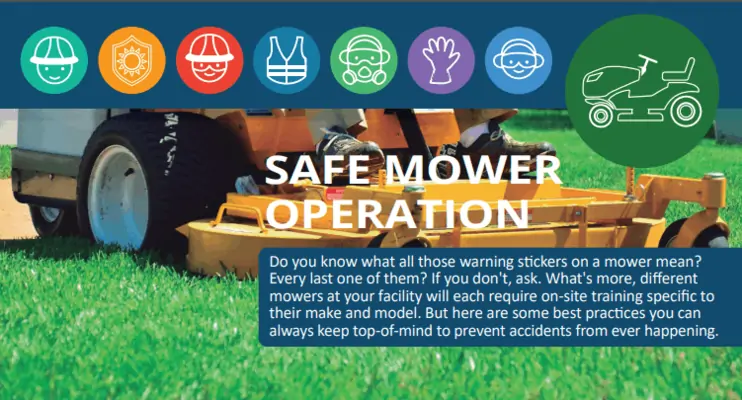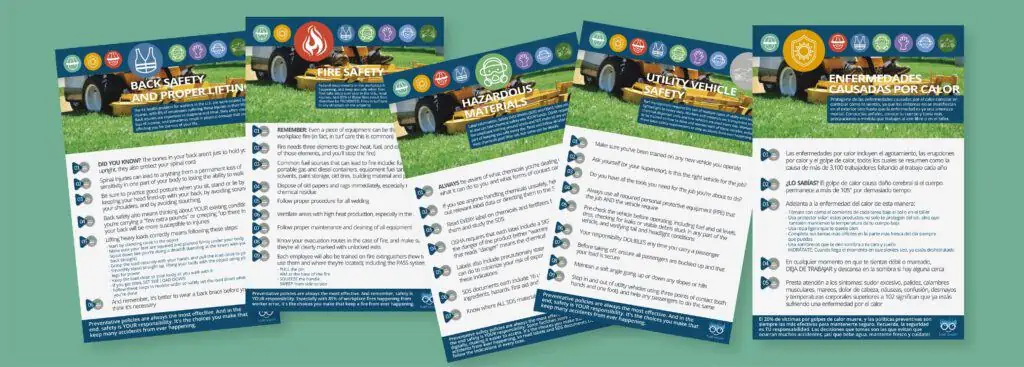
We’re talking about turf care, so this topic is a must. It’s the responsibility of every organization and every individual worker to ensure that everyone is aware of—and follows—the proper mower operation practices to avoid injury and increasing productivity.
Maintain awareness of the conditions at your work site, as well as your current surroundings on any given day. Be sure you’re familiar with each machine and each task, and you’ll be on your way to prevent accidents.
But we can get more specific than that. Follow along as we go over some best practices and safety regulations that you should always follow when operating a mower.
1. Dress appropriately for the job.
For starters, be sure to wear durable shoes or boots. No sandals or bare feet, as this is never safe around a mower.
In terms of fashion, long pants should be worn to shield your legs. Also, be sure not to wear any loose-fitting garments or jewelry, as these could get caught in the machine and cause serious injury.
And finally, don’t forget to protect your eyes and ears. Use personal protective equipment (PPE) such as eye goggles to shield your eyes from flying debris, and earplugs to protect against hearing damage due to extended exposure to the noisy engine.
2. Choose the right mower for the job.
The mower you use should be suitable to the turf and vegetation density of the task you’re assigned to. It should also be capable of cutting near obstacles and following contours in the ground without scalping.
If you’ll be mowing on inclines, you need to be sure to select a mower with suitable power.
3. Inspect the mower before you begin.
We’ll make this checklist as easy to follow as possible:
4. Follow safety precautions as you get ready to go out on the grounds.
Before you take off:
Once you arrive to the work area, inspect your work site. Be sure to clear the area before mowing, inspecting for debris and hazards such as broken glass, rocks, sticks, etc. Debris like this can cause serious injury both to the operator and passers-by when it is thrown into the air by mower impact.
You should also check the area for natural threats such as bees or certain forms of plant life if you have any allergies. Being aware of potential threats in the area will increase your safety and productivity.
Finally, be sure to look out for holes and extremely wet areas, which could make the ground slippery. Plan how you will adapt your deck to handle water edges and bunkers, and then you’re ready to get started.
5. Be extra cautious when mowing on slopes or hills.
It’s not easy to mow on a slope. If you do not take the proper precautions, it can also be very dangerous. Never attempt to ride your mower across the slope. Doing this could cause your mower to tip over.
If you remain in the seat when a mower flips, you could be crushed under the machine. For this reason, you should always mow up and down slopes on your rider mower. Be sure to reduce your speed on the way down, and when maneuvering sharp corners. Do not make any quick starts, stops or turns. Make broad, gradual turns and maintain a minimum ground speed.
6. Maintain three points of contact when climbing in or out of a rider mower.
Getting on or off your mower without getting hurt sounds easy enough, however, one-fourth of all accidents that happen to workers operating heavy machinery occur due to falling while getting on and off the equipment.
Yes, we were shocked by that, too.
To best guard against this, follow the three points of contact rule. In other words, always maintain three points of contact with the machine until you are fully on or off the equipment:
7. Do NOT use a cellphone use while mowing.
You should always pay close attention to your surroundings when you mowing. Be sure to maintain a safe distance from buildings, trees, signs, etc. Watch out for people or animals who might approach you. Stop mowing and shut off your engine if they get too close.
And remember, talking or texting on your cellphone can be distracting, causing you to not pay close enough attention to your surroundings. You may think you’re a pro at multitasking, but a single piece of debris in your path could prove you wrong.
Remember, at the end of the day safety is YOUR responsibility, so take safe mower operation seriously.
